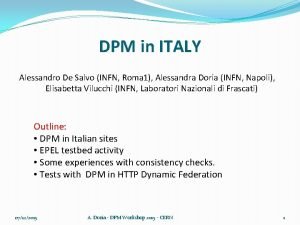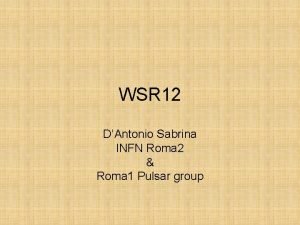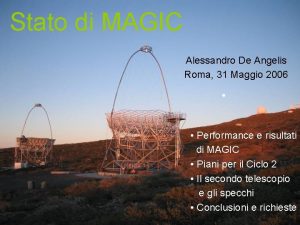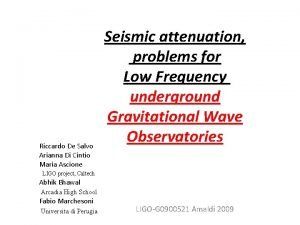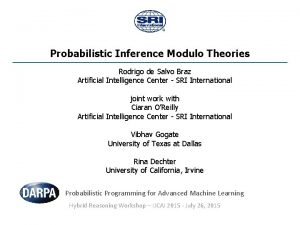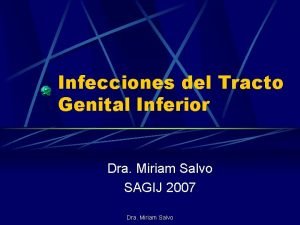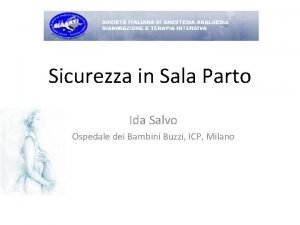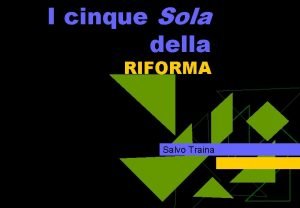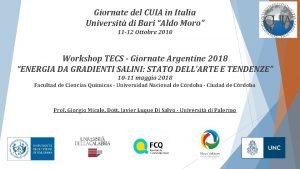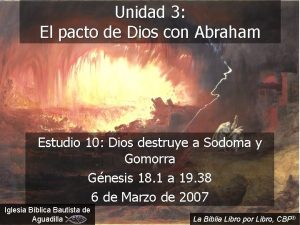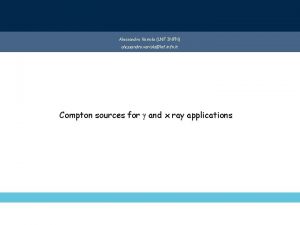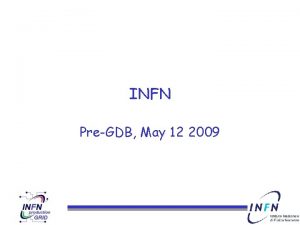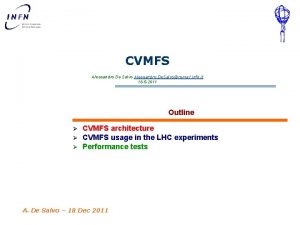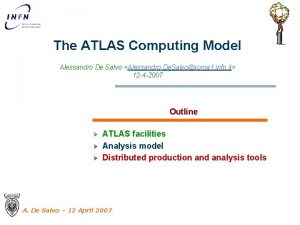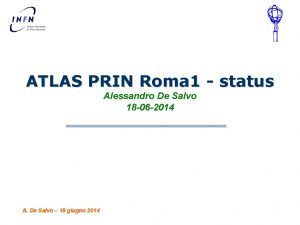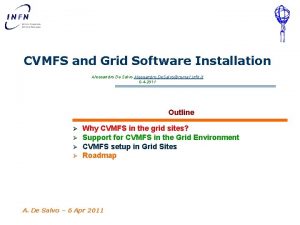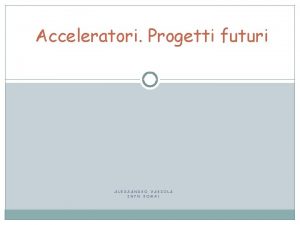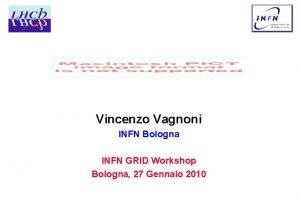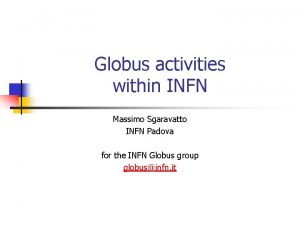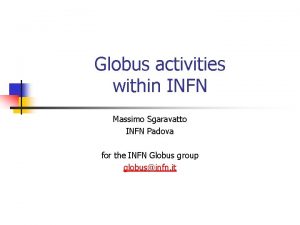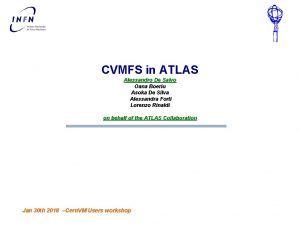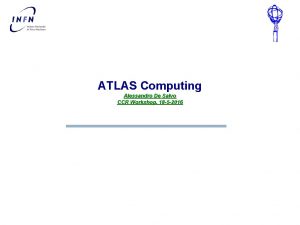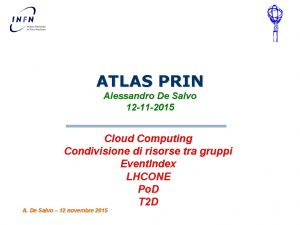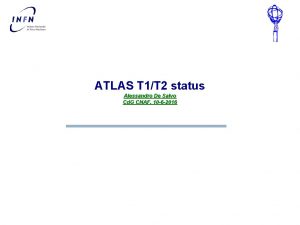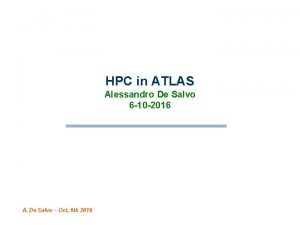INFN Roma Grid Activities Alessandro De Salvo Alessandro





















- Slides: 21

INFN Roma Grid Activities Alessandro De Salvo Alessandro. De. Salvo@roma 1. infn. it 7/5/2009 Outline § Introduction § Grid computing at INFN Roma § The Tier 2 Computing Center § Activities and perspectives § Conclusions

What is a grid? Relation to WWW? § Uniform easy access to shared information Relation to distributed computing? § Local clusters § WAN (super)clusters § § − Condor Relation to distributed file systems? § NFS, AFS, GPFS, Lustre, Pan. FS… § • A grid gives selected user communities uniform access to distributed resources with independent administrations – Computing, data storage, devices, … 7 -5 -2009 Alessandro De Salvo – Grid Activities in INFN Roma 2

Why is it called grid? § Analogy to power grid § You do not need to know where your electricity comes from § Just plug in your devices § You should not need to know where your computing is done § Just plug into the grid for your computing needs § You should not need to know where your data is stored § Just plug into the grid for your storage needs 7 -5 -2009 Alessandro De Salvo – Grid Activities in INFN Roma 3

Where do we use the grids? § Scientific collaborations § High-energy physics § Astrophysics § Theoretical Physics § Gravitational Waves § Computational chemistry § Biomed – biological and medical research − − Health-e-Child – linking pediatric centers WISDOM – “in silico” drug and vaccine discovery Earth sciences § UNOSAT – satellite image analysis for the UN § Can also serve in spreading know-how to developing countries Industry? Commerce? § Research collaborations § Intra-company grids Homes? Schools? § E-learning § § § 7 -5 -2009 Alessandro De Salvo – Grid Activities in INFN Roma 4

Grids in the World § The general INFN Roma computing infrastructure is part of the following Grids § § IGI (Italian Grid Infrastructure) WLCG (World LHC Computing Grid) EGEE (Enabling Grid for E-scienc. E) The most important grid users in Roma are § § The ATLAS experiment at LHC The CMS experiment at LHC The VIRGO experiment Theoretical Physics group 7 -5 -2009 Alessandro De Salvo – Grid Activities in INFN Roma 5

Why Grid at LHC? § 10 -15 Peta. Byte/year § Data analysis requires at least ~100 k typical PC processors § Scientists in tens of countries worldwide § CERN can provide up to 2030% of the storage and CPU § 70 -80% are provided by WLCG partners 7 -5 -2009 Alessandro De Salvo – Grid Activities in INFN Roma 6

Why Grid for VIRGO? § Gravitational wave detector Virgo has accumulated several months of data up to now (130 TB in total). The next scientific run, VSR 2, will start in July 2009 and will last ~6 months, producing additional ~130 TB of data § Some of the analysis to be carried on the data require large computational resources. In particular the ‘blind’ search for continuous gravitational signals from rotating neutron stars, an activity on which the Rome group has the leadership § VIRGO uses the grid to transparently access the computing resources needed for the analysis. The minimal amount of computing power needed to analyze 6 months of data is ~1000 dedicated CPUs for 6 months. The bigger the available computing power, the larger is the portion of the parameter space that can be explored (computing bounded problem) 7 -5 -2009 Alessandro De Salvo – Grid Activities in INFN Roma 7

Why Grid for Theoretical Physics? Study of the QCD properties, i. e. theory of the quark-gluon interactions § Mainly based on numerical simulations SU(3) Lattice QCD computations in 4 dimensions § § Computing requirements § Different requirements on RAM, depending on the lattice volume: § − 124, 144, 184 <--> 250 MB, 500 MB, 1. 1 GB respectively Trivial parallelism, using N copies of the same program with different initial random seeds (N=200 for the biggest lattice) § − Grid as a probability distribution generator Very small, optimized executable, written in C Using the SSE 2 set of instructions, available in the most recent Intel CPUs Very limited amount of disk space needed for the output 2005 -2006 (L. Giusti, S. Petrarca, B. Taglienti: POS Tucson 2006, PRD 76 094510 2007) § § − 134800 configurations ≈ 800000 CPU hours ⇒ ~1 year @ 100 CPU dedicated farm Last 1. 5 years − − 70 000 configurations (run) + 40000 configurations (test) ≈ 660000 CPU hours Work to be presented at Lattice 2009 Only possible via Grid Computing! − − − New lattice dimensions will require ≥ 2 GB of RAM and dedicated run sessions on more than 100 CPUs (or ~100 dedicated CPUs for 6 months) Challenge for the resources currently available in the grid 7 -5 -2009 Alessandro De Salvo – Grid Activities in INFN Roma 8

Organization of the Grid computing centers § § Example: the WLCG Tiered structure § § § Generally referred as “Tiers” The biggest sites, in terms of resources and support level, are at the top of the hierarchy (lower levels), while the smaller ones are at the bottom (higher levels) § WLCG Tier-2 sites The Grid Sites are organized hierarchically CERN (Tier-0) Regional (National) Centers (Tier-1 s) Local Centers (Tier-2 s) Canada TRIUMF Tier-1 centers Taiwan ASGC USA BNL NL SARANIKHEF UK RAL Tier-0 CERN France CCIN 2 P 3 Italy CNAF Spain PIC Nordic countries NDGF Germany USA FNAL FZK The sites located higher in the hierarchy are coordinating and supporting the sites below them ROMA 7 -5 -2009 Alessandro De Salvo – Grid Activities in INFN Roma 9

The INFN Roma Tier 2 center 7 cooling racks, expandable to 14 § § Self-conditioned, using water Remote Monitoring System Up to 40 units per rack − Hosted experiments § § ATLAS (WLCG Tier 2) § 286 CPU cores § § § DPM Storage ATLAS CMS (WLCG Tier 2) § 320 CPU cores § 110 TB storage space § § § LSF batch system ~200 TB storage space § LSF batch system d. Cache Storage VIRGO § 416 CPU cores § 10 TB storage space § § 7 -5 -2009 With the current CPU form factor, it would be ~9000 CPU cores! Torque/Maui batch system DPM Storage Alessandro De Salvo – Grid Activities in INFN Roma 10

Network connectivity for the Tier 2 center GARR Roma 1 -Tier 2 1 Gbps INFN Roma Tier 2 Center GARR Roma 1 1 Gbps INFN Roma Network Internal Network (ATLAS) @ 10 Gbps 7 -5 -2009 Alessandro De Salvo – Grid Activities in INFN Roma 11

Data processing using Grid tools ATLAS Data Transfer via the ATLAS DDM (DQ 2) Throughput (MB/s) in ATLAS (04 -05/2009) § Monte. Carlo Production § PANDA (Production ANd Distributed Analysis) − § User Analysis § § § http: //panda. cern. ch: 25880/server/pandamon/query? dash=prod PANDA GANGA (Gaudi / Athena a. Nd Grid Alliance) − http: //cern. ch/ganga Online Muon Calibration MC Production Jobs in ATLAS Italy (15 -04 -2009 / 04 -05/2009) 7 -5 -2009 MC Production Walltime (seconds) in ATLAS Italy (15 -04 -2009 / 04 -05/2009) Alessandro De Salvo – Grid Activities in INFN Roma 12

Grid services in Roma: the ATLAS Software Installation System § Core service for the ATLAS Software Installations in LCG/EGEE and OSG Grids § § § Presented at§ § CHEP 2007 Serving more than 200 sites in unattended or semi-automatic (assisted) mode Single instance running in Rome and serving all the ATLAS collaboration since 2003 Online view of the availability of the software deployment in all the LCG/EGEE (Europe) and OSG (Open Science Grid, US) sites On-demand installation, testing and management of the releases Based on the LJSFi (Light Job Submission Framework for Installation) engine, entirely developed in Rome for LCG in 2003, exanded to OSG n 2009 and planning to include Nordu. Grid (Nordic Countries) in the next months, unifying the Installation System for full WLCG ATLAS Collaboration − § § 7 -5 -2009 Work to be done here! Designed for multi-Grid and multi-VO operations https: //atlas-install. roma 1. infn. it/atlas_install Alessandro De Salvo – Grid Activities in INFN Roma 13

The ATLAS MDT calibration center Online Calibration of the Monitored Drift Tubes (MDT) of the ATLAS Muon Spectrometer § § § ATLAS Tier 0 COOL DB § § ATLAS DDM Local Calibration Data Splitter Local Oracle Calib. DB 7 -5 -2009 Local Oracle Calib. DB The LCDS Architecture SE Web UI Presented at CHEP 2009 Calibration Farm Roma Tier-2 Calibration Farm SE Munich Tier-2 Calibration Farm Michigan Tier-2 ( Ultra. Light Network) SE Data coming from CERN via the ATLAS Distributed Data Management system (aka DQ 2) must be processed in quasi-streaming mode to calculate the calibration constants in 24/48 hours 3 calibration centers (Michigan, Munich and Rome) share the calibration tasks in different regions of the detector The full calibration procedure is supervised in each center by an agent called Local Calibration Data Splitter (LCDS), fully integrated with the Grid and local tools needed The architecture design and the control tools are direct responsability of the INFN ATLAS Roma group LCDS Database (SQLite 3) LCDS engine Local Calibration Database (Oracle) Local Oracle Calib. DB Byte. Stream decoder Authorization System Storage interface File RFIO DCAP GSIFTP SRM LRMS interface LSF PBS SGE Condor ATLAS DDM Alessandro De Salvo – Grid Activities in INFN Roma Storage System Calibration Farm

Data processing using Grid tools CMS § § Monte. Carlo Production User Analysis § CRAB (CMS Remote Analysis Builder) − § https: //twiki. cern. ch/twiki/bin/view/CMS/SWGuide. Crab Offline Calibration Data Management from Phed. Ex https: //cmsweb. cern. ch/phedex/prod/Info: : Main 7 -5 -2009 Alessandro De Salvo – Grid Activities in INFN Roma 15

CMS ECAL calibration “on-line”: short term calibration (+laser monitoring correction) at CAF (CERN) “off-line”: long term calibration at Tier 2 Copy of single and double electron dataset in RECO and ALCARECO formats • Iterative calibration algorithms run every n pb -1 • Crystal calibration constants sent back to CERN • 7 -5 -2009 Alessandro De Salvo – Grid Activities in INFN Roma

Data processing using the Grid tools VIRGO § § Mainly used for Data Analysis Computing resources accessible by • • • § Farm utilization in Roma since January 2009 • • 43000 jobs 252800 h total CPU time VIRGO (higher priority) THEOPHYS ARGO Raw data are produced in Cascina and copied to Tier-1 s Calibrated data are replicated in (some of the) Tier-2 (Roma, Pisa, RFKI) Tier-0 Cascina Tier-1 Tier-2 CNAF Roma 7 -5 -2009 Pisa Lyon Nikhef APC-Parigi RFKI-Budapest Alessandro De Salvo – Grid Activities in INFN Roma 17

Data processing using the Grid tools Theoretical Physics 2005 - 2007 Plots from the Grid Monitoring Systems http: //gridice 4. cnaf. infn. it: 50080/gridice/site. php https: //dgas. cnaf. infn. it 7 -5 -2009 Alessandro De Salvo – Grid Activities in INFN Roma 18

Summary of the Grid-related activities in Roma § LHC experiments § § § ATLAS and CMS calibration activities ATLAS Software Installation in the Grid sites European projects § WLCG (World LHC Computing Grid) and EGEE (Enabling Grid for E-scienc. E) − High Energy Computing Clusters [ATLAS] • High-level Job Scheduling system (Job Priority) − LCG 3 D Distributed Database System • Mostly related to the Oracle installation for the ATLAS calibrations • Active backup of the ATLAS LCG File Catalog at CNAF − Work presented at CHEP 2009 § Grid Computing in Roma Italian Grid Infrastructure (IGI) § High-performance storage systems − − − § d. Cache [CMS] DPM [ATLAS, VIRGO] Sto. RM [ATLAS] ATLAS Alessandro De Salvo Daniela Anzellotti Danilo D’Angelo Franco Marzano Lamberto Luminari CMS Cristina Bulfon Giovanni Organtini Leonardo Sala (Milano) Luciano M Barone Massimo Nuccetelli VIRGO Alberto Colla Cristiano Palomba Theoretical Physics Silvano Petrarca Workload Management System interaction with HEP Clusters [ATLAS] 7 -5 -2009 Alessandro De Salvo – Grid Activities in INFN Roma 19

Conclusions § Roma is fully integrated with the Italian Grid Infrastructure and the WLCG systems § The ATLAS and CMS collaborations are actively using the resources located in Roma to produce Monte Carlo data, perform user analysis and computation of calibration constants § The system is robust and powerful enough to cope with the incoming LHC data taking § Other experiments or groups (VIRGO and the Theoretical Physics) are already actively using the grid services to cope with their computing requirements § Several Grid-related activities are present in Rome § § Included in Italian, European and/or Worldwide projects Room for further development and improvements § Always trying to improve the levels of reliability and stability of the systems § All the users in Roma are invited to take advantage of the experience of the people involved in the Grid projects and join the efforts § The Grid is waiting for you! 7 -5 -2009 Alessandro De Salvo – Grid Activities in INFN Roma 20

More information http: //igi. cnaf. infn. it http: //www. cern. ch/lcg http: //www. eu-egee. org http: //www. gridcafe. org ATLAS http: //atlas. web. cern. ch http: //cms. web. cern. ch http: //www. virgo. infn. it 7 -5 -2009 Alessandro De Salvo – Grid Activities in INFN Roma 21
 Alessandro de salvo
Alessandro de salvo Dpm italy
Dpm italy Infn roma tor vergata
Infn roma tor vergata Infn roma 2
Infn roma 2 Blank de angelis
Blank de angelis O que fazer para ser salvo
O que fazer para ser salvo Ves triplet
Ves triplet Salvo termopoder
Salvo termopoder Maria ascione
Maria ascione Rodrigo de salvo braz
Rodrigo de salvo braz Eli foi salvo
Eli foi salvo Miriam salvo
Miriam salvo Ida salvo
Ida salvo Salvo termopoder
Salvo termopoder Como ser salvo y saberlo
Como ser salvo y saberlo Cinque sola
Cinque sola Donna salvo
Donna salvo Javier luque di salvo
Javier luque di salvo Abraham intercede por sodoma y gomorra
Abraham intercede por sodoma y gomorra Este camino ya nadie lo recorre salvo el crepúsculo
Este camino ya nadie lo recorre salvo el crepúsculo Pin grid array and land grid array
Pin grid array and land grid array Support activities and primary activities
Support activities and primary activities

